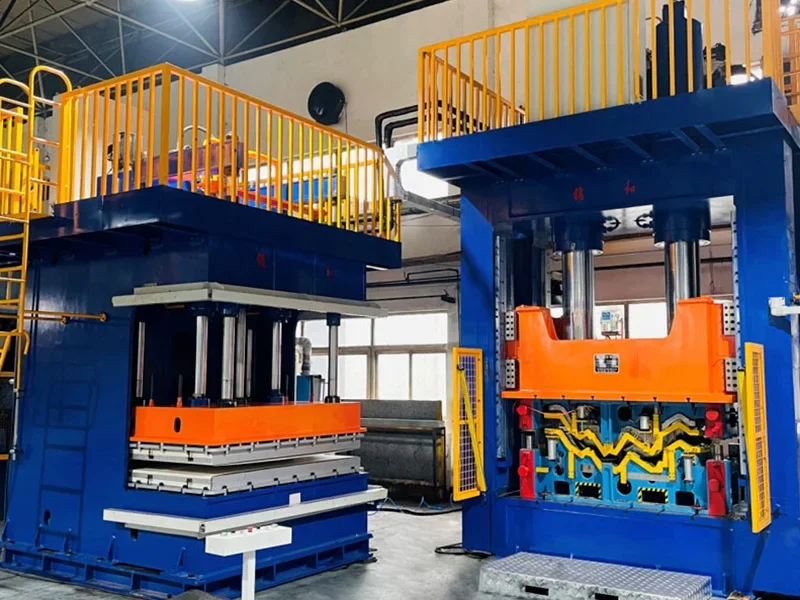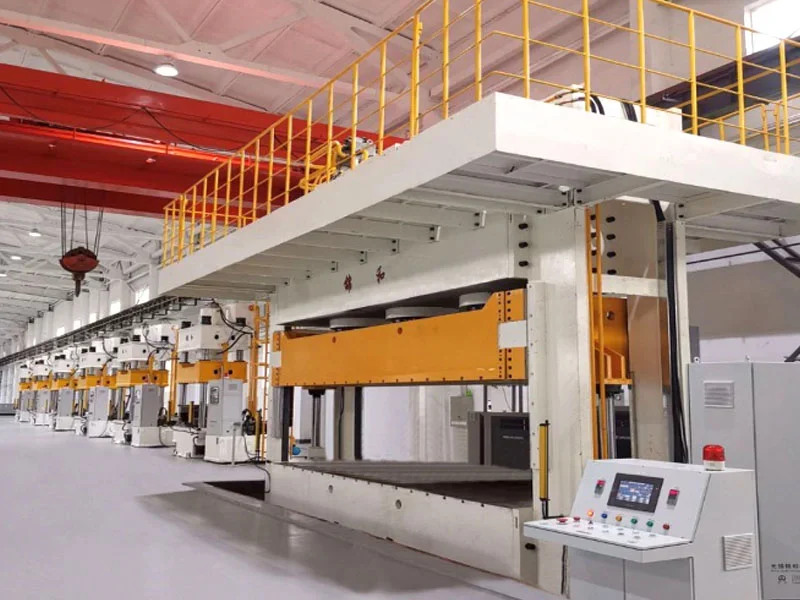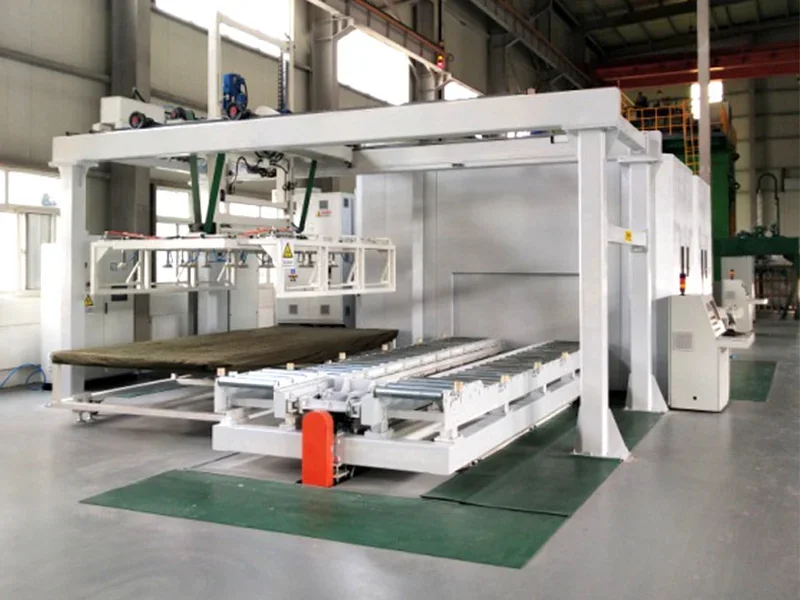Discover the power of composite press materials in revolutionizing the world of manufacturing. From enhancing durability to reducing weight, composite press components offer a myriad of benefits for various industries. This blog post delves into the versatility and efficiency that composite press technology brings to modern production processes. Explore how these advanced materials are reshaping the way products are designed, manufactured, and utilized across different sectors. Uncover the innovative solutions and cost-effective advantages that composite press materials provide, propelling industries towards a more sustainable and high-performance future.
Understanding Composite Press Basics
Definition of Composite Press
A composite press is a machine used in manufacturing to combine materials such as fibers and resins to create composite materials. It applies heat and pressure to bond the materials together, forming strong and durable products.
Composite presses play a crucial role in industries like aerospace, automotive, and construction by enabling the production of lightweight yet robust components.
Materials Processed by Composite Presses
Composite presses can work with various materials, including carbon fiber, fiberglass, Kevlar, and thermoplastics. These materials are commonly used in manufacturing due to their high strength-to-weight ratio and resistance to corrosion.
The versatility of composite presses allows manufacturers to produce a wide range of products, from aircraft parts to sports equipment, with exceptional strength and durability.
Importance of Temperature and Pressure Control
Temperature and pressure control are vital aspects of composite pressing. Maintaining precise temperature levels ensures that the materials cure properly without overheating or under-heating, which can compromise the structural integrity of the final product.
Similarly, controlling pressure during the pressing process helps eliminate air pockets or voids within the composite material, ensuring uniformity and strength throughout the finished product.
Key Features of Composite Presses
Types
Composite presses come in various types, including hydraulic, pneumatic, and electric presses. Each type offers unique advantages.
Hydraulic composite presses utilize fluid power to generate pressure, ideal for high-force applications. Pneumatic presses use compressed air for lighter operations, while electric presses are known for their precision control.
Customizable Settings
One of the key features of composite presses is their customizable pressure and temperature settings. This flexibility allows manufacturers to tailor the pressing conditions to suit different materials and processes.
By adjusting the pressure and temperature parameters, users can achieve optimal results in terms of material properties, curing times, and overall product quality.
Automation and Safety
Modern composite presses often feature automation capabilities such as programmable controls and touch-screen interfaces. These automation features streamline the pressing process, increasing efficiency and consistency.
Moreover, safety is a top priority in composite press design. Built-in safety mechanisms such as emergency stop buttons, light curtains, and interlocking systems ensure operator protection during operation.
Operating Mechanisms Explained
Platens
Platens in a composite press play a crucial role by providing a flat surface for materials to be compressed. They are typically made of steel to withstand high pressure and heat during the pressing process. The size and thickness of platens vary based on the specific requirements of the materials being processed.
Hydraulic Systems
Hydraulic systems are integral to the operation of a composite press as they generate and control the pressure needed for pressing materials together. These systems consist of hydraulic pumps, cylinders, valves, and hoses that work together to apply force evenly across the platens. Proper maintenance of hydraulic systems is essential to ensure consistent performance and prevent breakdowns.
Heating Elements
Heating elements are responsible for raising the temperature inside the press to facilitate curing or bonding processes. They are strategically placed within the platens to ensure uniform heating across the entire surface area. The temperature and heating duration can be adjusted based on the specific requirements of the materials being processed.
Maintenance Practices
Regular maintenance is key to ensuring optimal performance and longevity of a composite press. Some common maintenance practices include:
-
Regularly inspecting and replacing damaged platens to maintain uniform pressure distribution.
-
Checking hydraulic fluid levels and replacing them as needed to prevent system failures.
-
Calibrating heating elements periodically to ensure accurate temperature control during operations.

Control Systems Overview
Types of Control Systems
Composite presses utilize control systems that can be categorized into manual and automated systems. Manual control systems require operators to adjust settings physically, offering a hands-on approach to monitoring and regulating the press operation. On the other hand, automated control systems use sensors and actuators to manage processes automatically, enhancing efficiency and precision.
Benefits of Real-Time Monitoring and Data Logging
Real-time monitoring in control systems provides immediate feedback on press operations, allowing operators to make quick adjustments to optimize performance. Data logging enables the recording of critical parameters over time, facilitating analysis for process improvement and troubleshooting. These features enhance productivity and ensure consistent quality in composite manufacturing.
Integration of Industry 4.0 Technologies
The integration of Industry 4.0 technologies in composite press control systems revolutionizes manufacturing processes by enabling connectivity and smart functionalities. By incorporating IoT devices, artificial intelligence, and machine learning algorithms, Industry 4.0 enhances automation levels and decision-making capabilities within the system. This integration leads to predictive maintenance, improved energy efficiency, and overall optimization of production processes.
Structural Components Insight
Frames
Composite presses consist of frames that provide structural support and stability during the pressing process. The frames are typically made of durable materials like steel or aluminum to withstand high pressure and ensure precision in molding composite parts.
Frames play a crucial role in maintaining the overall rigidity of the press, preventing any deformation or misalignment during operation. A sturdy frame is essential for achieving consistent and accurate results in composite pressing applications.
Platens
Platens are another essential component of a composite press, serving as the surfaces where the actual pressing of materials takes place. These flat metal plates come in direct contact with the composite materials and apply pressure evenly across the mold cavity.
Platens are often heated to specific temperatures to facilitate the curing process of composites, ensuring uniform distribution of heat throughout the material. The quality and material of platens significantly impact the final finish and strength of molded products.
Hydraulic Systems
The hydraulic systems in composite presses are responsible for generating and controlling the immense force required for pressing operations. These systems use hydraulic fluid to transmit power from pumps to actuators, which then exert pressure on the molds.
Hydraulic systems play a critical role in regulating pressure levels, speed, and force distribution during pressing cycles. Proper maintenance and monitoring of hydraulic components are essential to prevent issues such as leaks or malfunctions that can affect press performance.
Materials Used
Composite press components are commonly manufactured using materials like steel, aluminum, or carbon fiber composites. These materials offer a balance between strength, durability, and weight, ensuring optimal performance during pressing operations.
The choice of materials for frames, platens, and hydraulic components directly impacts the overall efficiency and longevity of a composite press. High-quality materials enhance structural integrity, minimize wear and tear, and contribute to consistent production output.
Importance of Structural Integrity
Maintaining structural integrity is paramount for ensuring long-term reliability and precision in composite pressing processes. Any compromise in the structural components can lead to issues such as misalignment, uneven pressure distribution, or mold defects.
A well-maintained composite press with robust structural components not only delivers superior product quality but also reduces downtime due to repairs or part replacements. Investing in high-quality materials and regular maintenance enhances overall productivity and operational efficiency.

Applications of Composite Presses
Industries
Various industries, from aerospace to automotive, extensively utilize composite presses for manufacturing components. These industries rely on the versatility and efficiency of composite materials.
In the aerospace sector, composite presses play a crucial role in producing lightweight yet robust parts for aircraft, enhancing fuel efficiency and overall performance. Similarly, automotive companies leverage these presses to create strong and durable components that contribute to vehicle safety and longevity.
Specific Applications
Molding: Composite presses are commonly used for molding processes, where materials are shaped into desired forms under high pressure. This application ensures precise and consistent product outcomes, vital for quality control in manufacturing.
Laminating: Another key application of composite presses is laminating, where layers of different materials are bonded together to enhance strength and durability. This process is essential in creating composite structures with superior mechanical properties.
Forming: Composite presses are also instrumental in forming operations, where materials are shaped or bent to achieve specific geometries. This application is critical in customizing components according to design requirements, offering flexibility in production processes.
Advantages
The use of composite presses offers several advantages in the manufacturing industry. Firstly, these presses enable the production of lightweight components without compromising on strength, making them ideal for applications where weight reduction is critical.
Moreover, composite materials processed using these presses exhibit exceptional resistance to corrosion and fatigue, enhancing the longevity of the final products. This durability factor is particularly beneficial in industries such as aerospace and automotive, where reliability is paramount.
Composite presses facilitate efficient production cycles by reducing processing times and material waste. The precision and control provided by these machines ensure high-quality outputs consistently, leading to cost savings and improved productivity for manufacturers.
Speed and Efficiency Factors
Cycle Times
Composite pressing speed heavily relies on cycle times which encompass the duration for each step in the process. Shorter cycle times lead to increased productivity and reduced manufacturing costs.
Optimizing cycle times involves streamlining operations, ensuring precise control over heating and cooling phases, and minimizing idle periods.
Pressure Distribution
Uniform pressure distribution across the mold surface is crucial for achieving consistent part quality. Inadequate pressure can result in defects like voids or resin-rich areas.
Advanced composite presses utilize sophisticated hydraulic systems to ensure even pressure distribution, enhancing part strength and dimensional accuracy.
Heating Uniformity
Maintaining uniform heating throughout the mold is essential for efficient composite pressing. Variations in temperature can cause curing inconsistencies and compromise part integrity.
Technological advancements enable precise control of heating profiles, ensuring optimal temperature uniformity across the mold cavity.
Process Automation
Implementing process automation reduces manual intervention, minimizing errors, and improving overall production efficiency. Automated systems enhance repeatability and reduce labor costs.
Automation also enables real-time monitoring of key parameters such as force, temperature, and cycle times, leading to enhanced process control.
Parameter Tuning
Fine-tuning process parameters such as tf (time to force) and dwell time can significantly impact pressing speed and efficiency. Adjusting these variables optimizes material flow and consolidation.
By optimizing parameters based on material properties and mold complexity, manufacturers can achieve faster cycle times without compromising part quality.
Case Studies
In a recent case study, a manufacturer implemented advanced composite press technology resulting in a 30% reduction in cycle times. By optimizing pressure distribution and heating uniformity, they achieved higher production throughput with improved part quality.
Another example showcases how automated parameter tuning led to a 20% increase in efficiency for a composite pressing operation. The precision control over key variables enabled consistent part quality while reducing overall manufacturing costs.

Summary
The exploration of Composite Presses has shed light on their fundamental aspects, from their operational mechanisms to structural components and diverse applications. Understanding the key features and control systems has emphasized the significance of speed and efficiency factors in optimizing production processes. The insights provided offer a comprehensive overview for individuals seeking to delve into the realm of Composite Press technology.
For those looking to enhance their knowledge further, delving into the intricate details of Composite Presses can unlock a world of opportunities in various industries. By grasping the nuances of these machines, one can harness their capabilities to streamline operations and achieve superior outcomes. Embracing continuous learning and staying updated on technological advancements will undoubtedly pave the way for innovation and success in this dynamic field.
Frequently Asked Questions
What are the key features of Composite Presses?
Composite presses feature high precision control systems, robust structural components, and efficient operating mechanisms. They are designed to provide uniform pressure distribution for composite materials during the molding process.
How do Composite Presses enhance speed and efficiency in manufacturing processes?
Composite presses optimize cycle times by ensuring consistent pressure application and temperature control. This results in faster production rates and improved overall efficiency in manufacturing composite products.
What are the common applications of Composite Presses?
Composite presses are widely used in industries such as aerospace, automotive, and sports equipment manufacturing. They are essential for producing composite parts like aircraft components, automotive body panels, and sporting goods due to their precision molding capabilities.
What is the role of Control Systems in Composite Press operations?
Control systems in composite presses regulate parameters such as pressure, temperature, and curing time to ensure precise molding of composite materials. These systems contribute significantly to maintaining quality standards and consistency in the manufacturing process.
How do Structural Components impact the performance of Composite Presses?
The quality and design of structural components directly influence the durability and reliability of composite presses. Sturdy frames, platens, and hydraulic systems are essential for withstanding high pressures during molding operations and ensuring long-term operational effectiveness.
